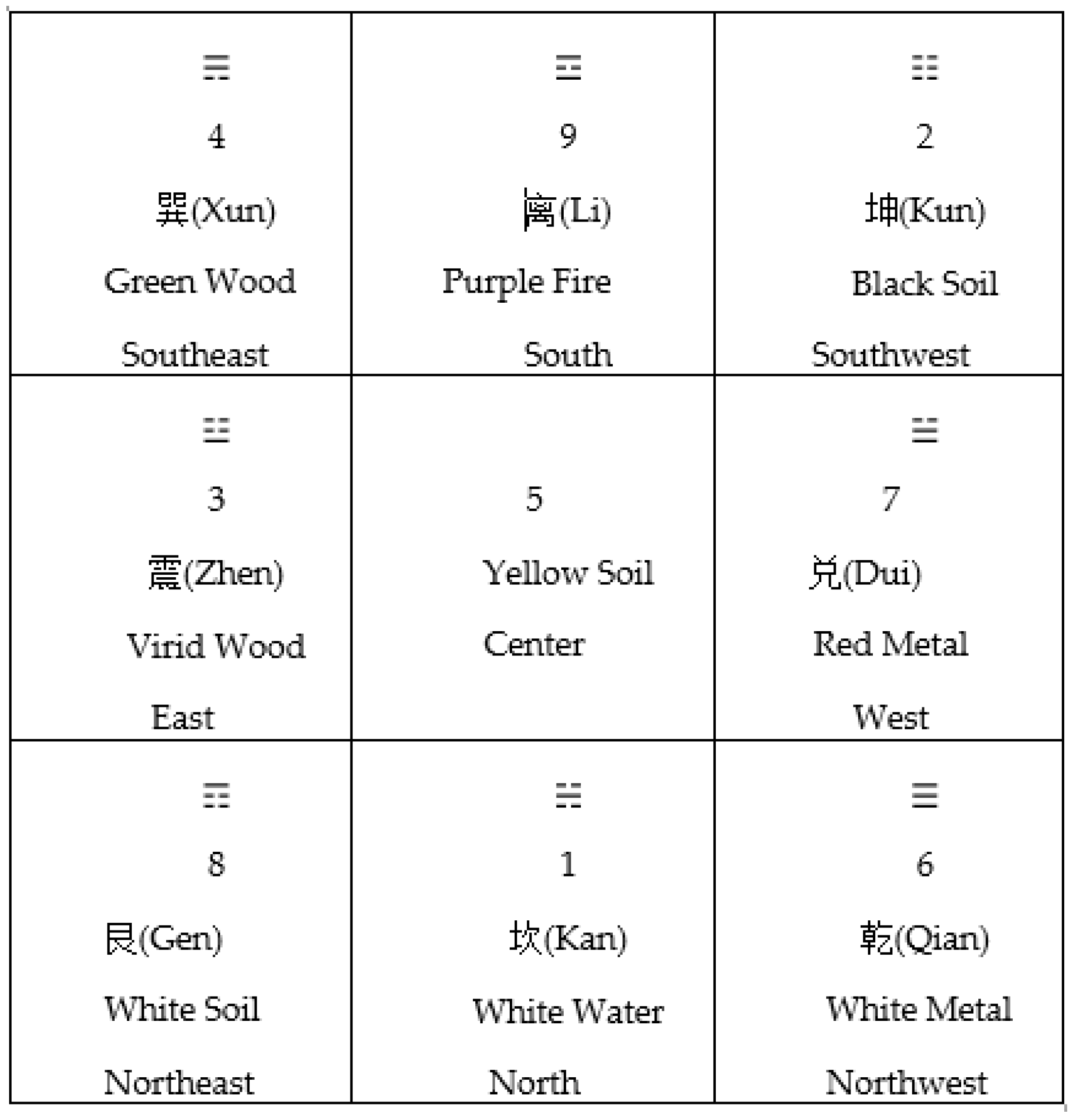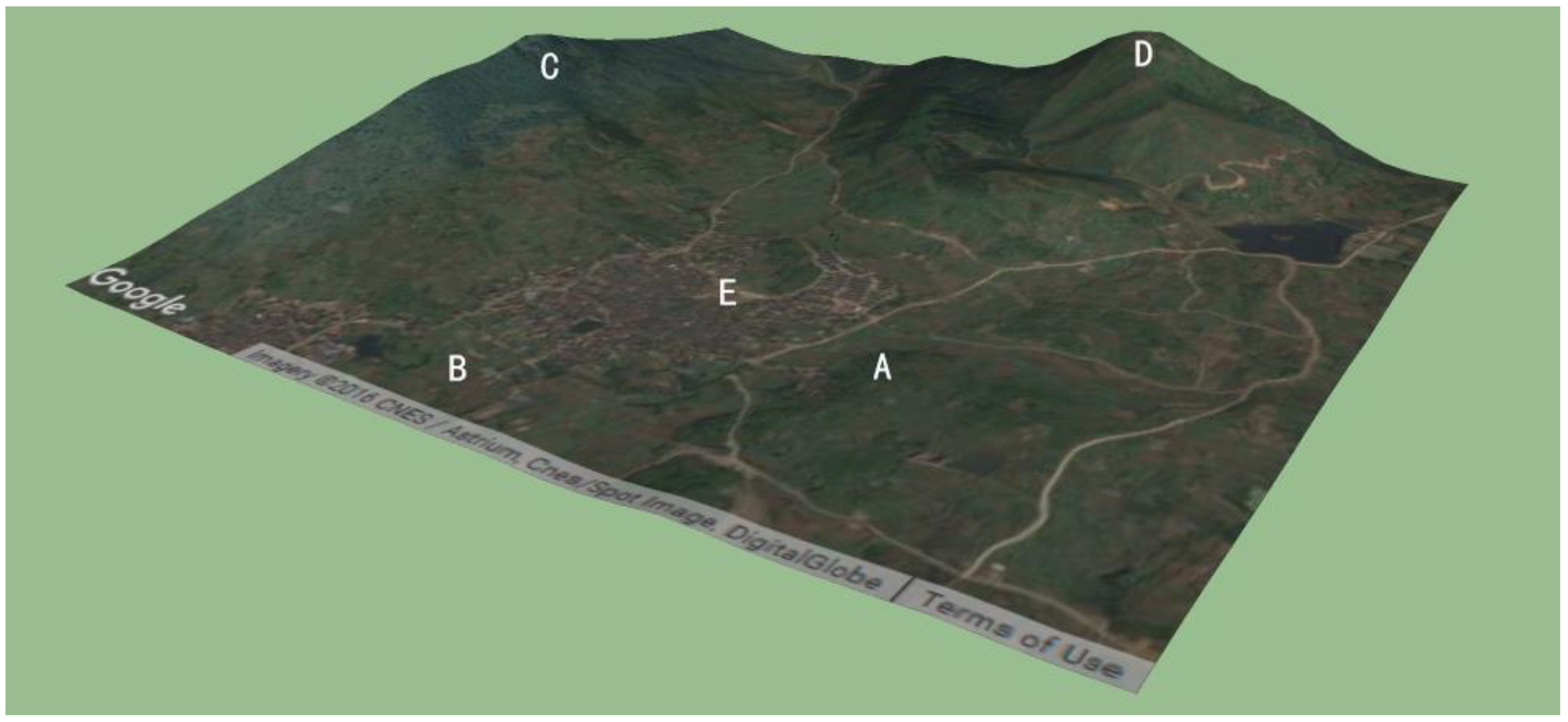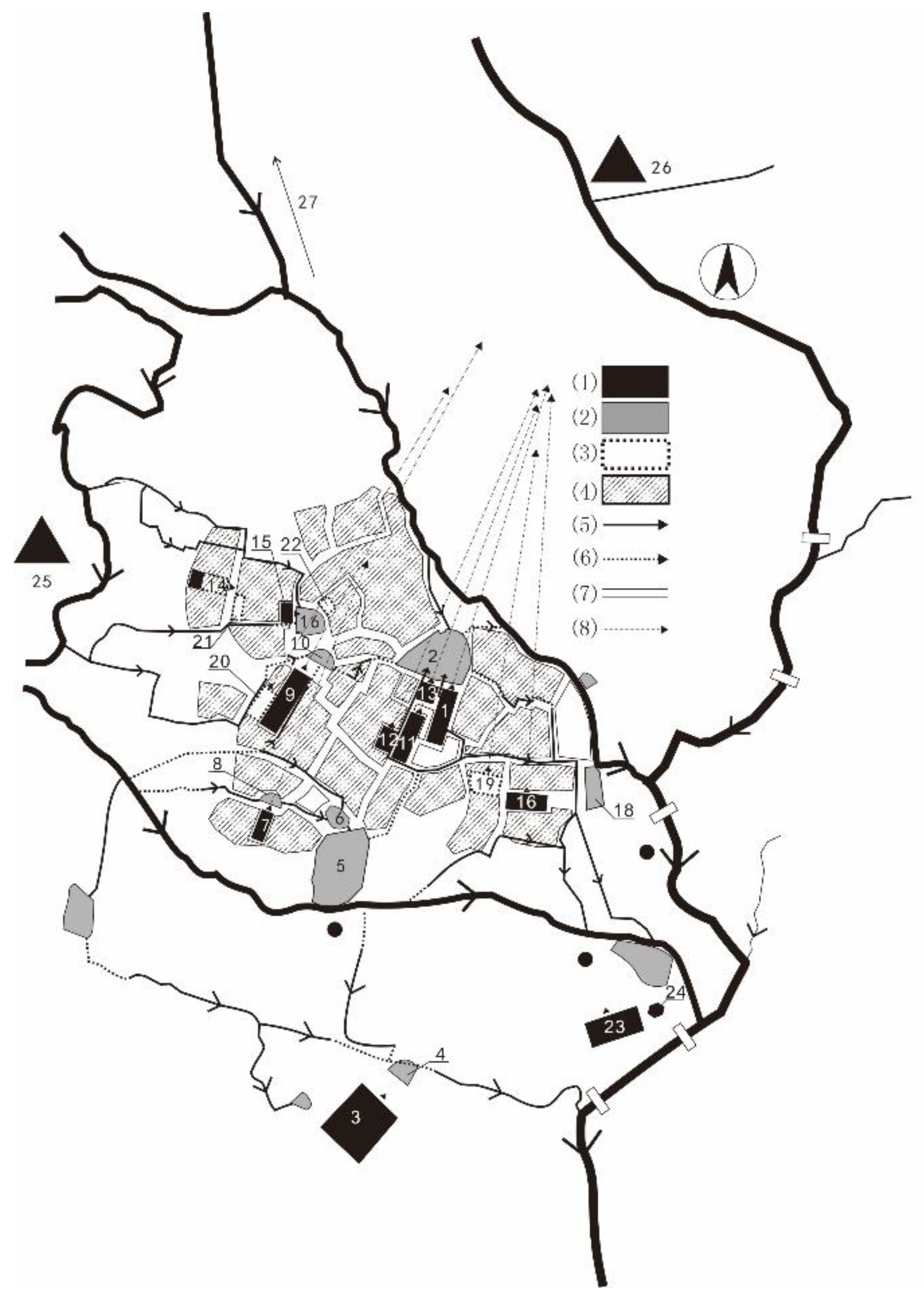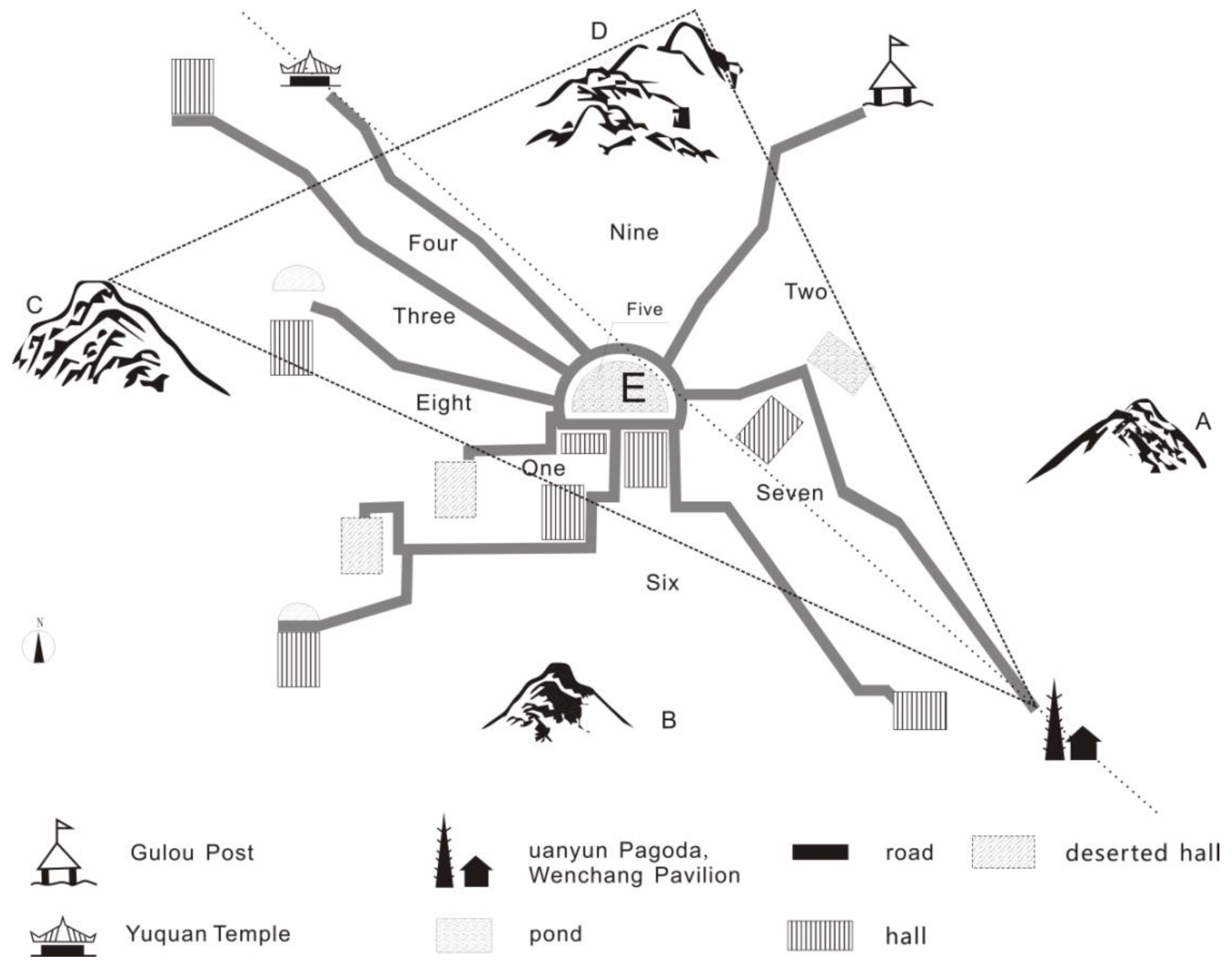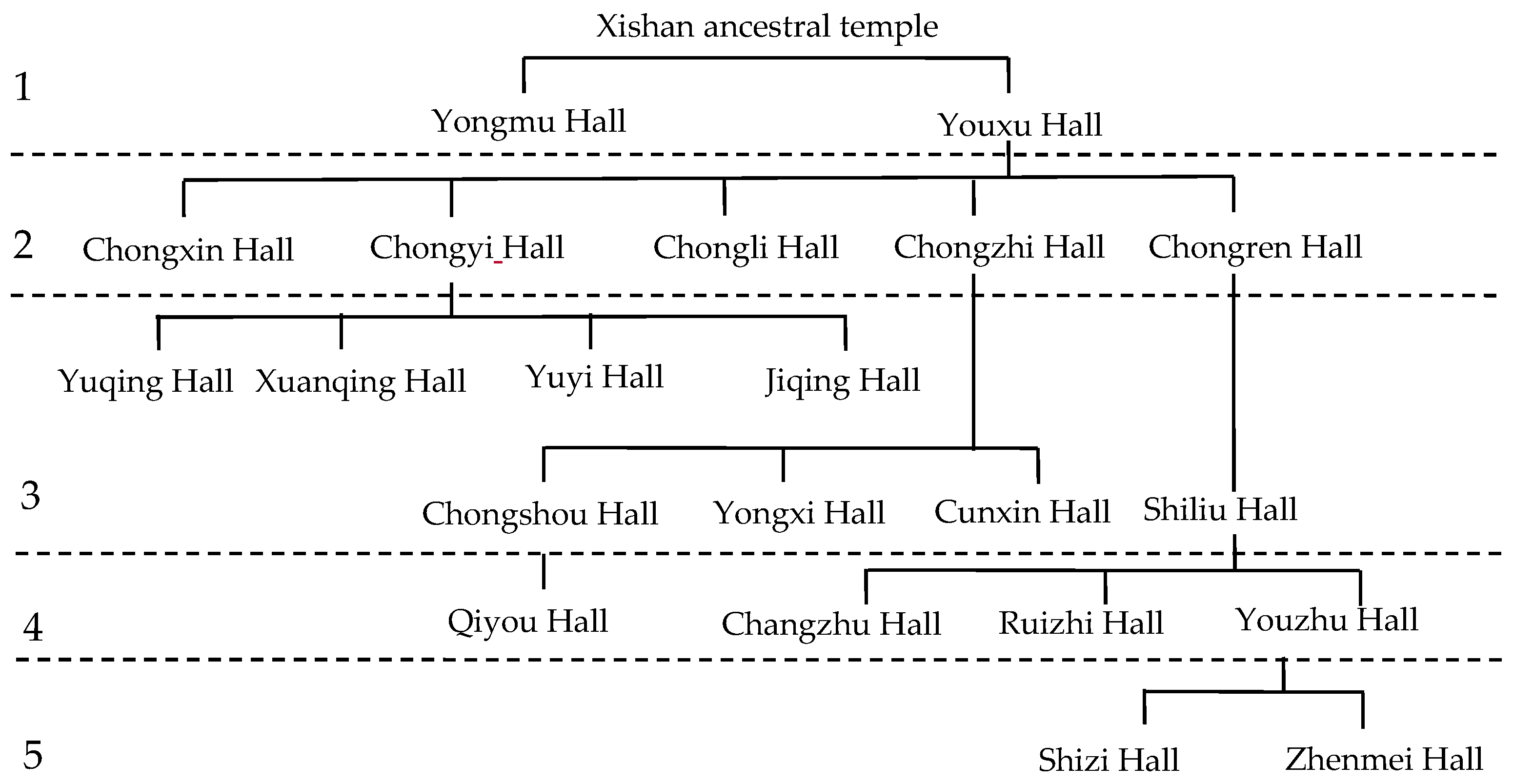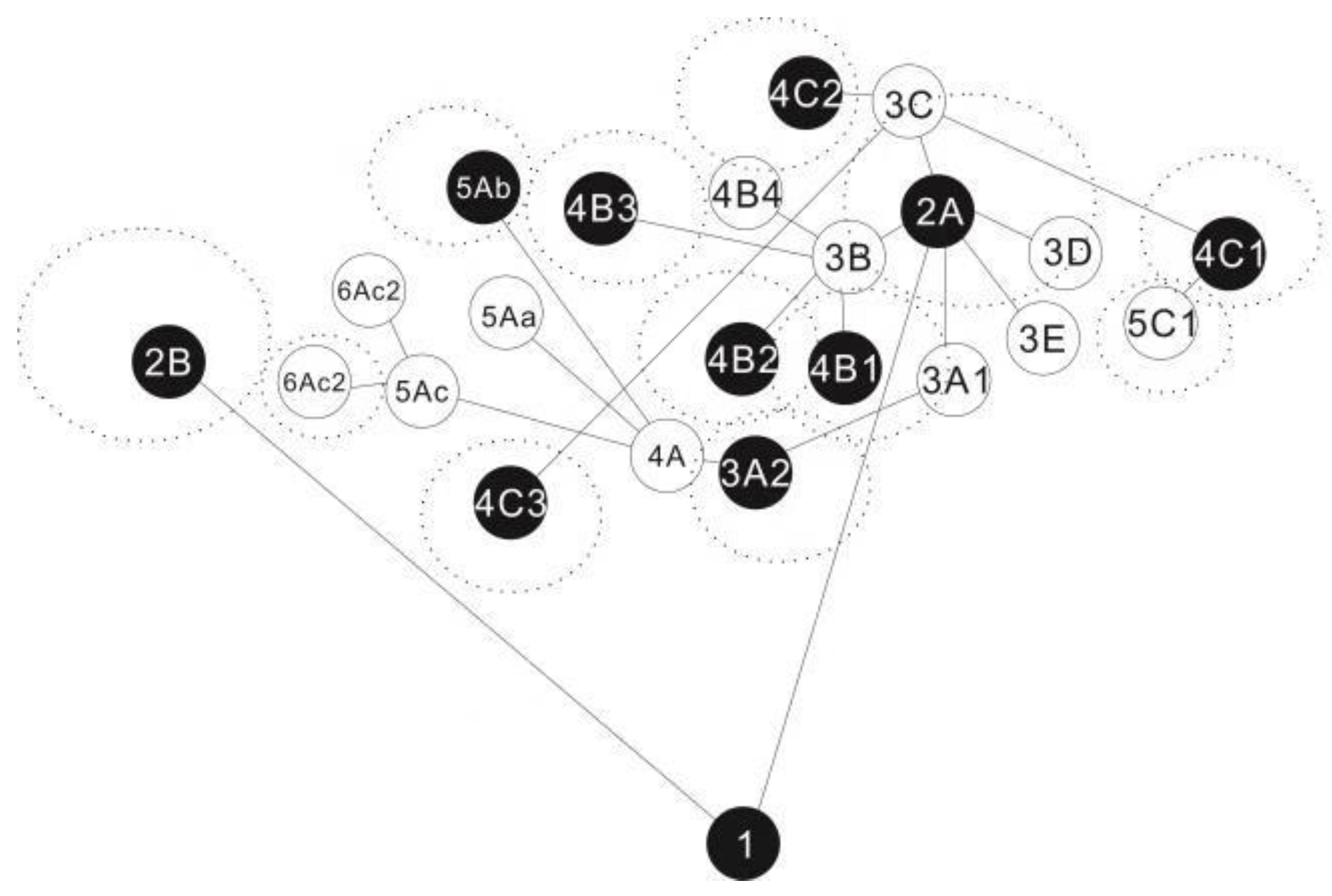Public space and public life form an interdependent relationship. Specific public life requires a specific structure of public space. The pluralistic way of life and culture will split the public space, make it full of conflicts and competition fields, and the competition for public space will lead to the change of the public landscape. With the development of Xinye Village, clan differentiation has appeared since the Ming Dynasty. The living space around the branches of the ancestral hall forms a “mass” of public landscape characteristics. The differentiated ancestral hall construction has planning significance for the layout of the public landscape. According to the Yuhua Ye genealogy, there are 22 ancestral halls in Xinye Village based on ethnic groups, and 11 of them are still in existence. It not only creates the sacrificial, festival and entertainment space for the settlement, but also creates the unique public landscape. In the whole process of development and change, the public space creates competition with each other, breaking through the original space order of “five elements and nine palaces,” and constantly reconstructing its new public landscape order.
5.2.1. Competition in the Public Space
In Chinese culture, there is a kind of ethnic “cultural circle”, which emphasizes the unequal relationship between “not my ethnic” and “my ethnic” [
36]; therefore, after ethnic differentiation, there will inevitably be a “competition”. In traditional Chinese military law, there is much wisdom about “competition”. It points out the reasons of the competition, that is, striving for fame and fortune, accumulating contradictions, producing civil strife and striving for living resources. The important reason for the “competition” of public space is the competition between power and economy. For villages, the “competition” between ancestral halls is the main way to fight for survival power and living resources. For example (
Table 2), the existing public space in Xinye Village includes religion, culture and ancestral belief space. There is a persistent competition between these public spaces. The scale of stable public space is larger than that of unstable public space: for ethnic groups with small power, their ancestral halls are usually small in scale, easy to decay, abandon or have even collapsed. Ancestral halls of powerful ethnic groups are flourishing and have gradually differentiated into new branch ancestral halls. In addition to the orderly hall, Rongren Hall, Luoqing Hall, Rongshou Hall and Rongzhi Hall in Sanshitian village all have drama stages. In front of the powerful ancestral hall of the family, there are open space with squares and ponds, and the environment will be solemn and comfortable. Among the 13 existing ancestral halls, there are ponds in front of Youxu Hall, Rongren Hall, Rongshou Hall, Changzhu Hall, Chunxin Hall, Changzhu Hall and Xishan Temple. In addition, Yongxi Hall and Youxu Hall share the “South Pond”. There are lotus ponds in front of Wenchang Pavilion and ponds beside Tuányun Tower. The more stable public spaces—Wenchang Pavilion, Tuányun Tower, Xishan Temple and Yuquan Temple—have very large squares.
In recent years, the creation of public space closely related to rural landscape has become more and more innovative. The restoration, reconstruction and abandonment of public space such as Xinye Village ancestral hall, and the restoration and expansion of some branch ancestral halls reflect the people’s national consciousness. Xishan ancestral temple (now the total ancestral temple), Ming Dynasty (1531) moved to the north of the Tuányun Tower, Qing Dynasty (1759) reconstruction; Youxu Hall (Outer House), Ming Dynasty (1505–1521), Qing Dynasty (1795–1820) expansion, reconstruction in 1926; Chongzhi Hall, rebuilt in the early Qing Dynasty, is now moving to Sanshitian village; Chongren Hall was relocated at the end of Ming Dynasty and rebuilt in Qing Dynasty (1880); Chunxintang was rebuilt in Qing Dynasty (1795–1820) and 1950; Xuanqing Hall was rebuilt in Qing Dynasty (1880) and in the eighteenth year (1929) of the Republic of China. Tuányun Tower was hit by a typhoon in the 1990s and repaired in 1999. Wenchangge, rebuilt in the Qing dynasty from 1862 to 1874; Yuquan temple, in the Qing dynasty (1821–1850) by the local 18 ethnic groups to rebuild cooperation. In addition, Chongxin Hall, Chongzhi Hall, Chongyi Hall, Yu Qingtang, Qiyou Hall, Youzhu Hall and Zhenmei Hall have no architectural space and no ruins. Of them, Shiliu Hall remains only the ruins of steps and patios. Qiyou Hall was caught in a fire in 1949. Its ruins have been occupied by other ethnic groups; Shizi Hall remains; Chongzhi Hall and its ethnic groups have moved to the nearby Sanshitian Village.
(1) “Competition” for Space Power
The “ancestral temple” is the “sacred space” of “family” in traditional Chinese settlements. Being endowed with cultural significance and place spirit, it is the symbolic space of family organization and authority, and the core "public space" of competition culture. According to the genealogy of the settlements, in “Xinye Village”, there are several ancestral temples for worship. Based on ethnic groups, there are 22 ancestral temples, forming a unique “ancestral temple group” (
Figure 7). Everyone associates their dwelling place with the ancestral temple as the “center” to gain their status in ethnic history and society. Ancestral temple groups have maintained the public order and security of villages for more than 700 years. The phenomenon of “survival of the fittest” in the “competition” hides the life rule of “public space”. The stability and persistence of the “ancestral temple group” can reflect the development, prosperity and decline of a “consanguineous” village [
12]. The public space landscape of ancestral temple, which is linked by “blood”, can not only meet the function of village public gathering, but also meet the needs of spiritual belief, reflect the collective characteristics of its society, and reconcile the common contradictions and problems of the society [
19].
Therefore, the public space “ancestral temple group” in Xinye Village has two functions: one is to satisfy the spiritual sustenance of “ancestral belief” space, which serves as a place of worship and festival, and plays the role of connecting the public consciousness of ethnic groups; the other is to meet the needs of daily public life, which is the material space to carry out village gatherings, entertainment and so on—an important place for public activities. With the growth of the village population, they will have the expansion of human settlements, the antagonism of ethnic interests under limited resources, the differentiation of public consciousness, and the establishment of branch ancestral halls by different tribal groups [
36]. During the development of ancestral temples in branches, conflicts among ethnic groups have been accumulated in order to compete for living space and living resources, resulting in civil unrest. Challenges faced by ancestral temples in branches have led to a crisis of decline in villages; some ancestral temples of branches and veins disappeared or became dilapidated due to the extinction or weakness of the clansmen, and even were occupied by other ethnic groups. In a word, the public space of “ancestral temple group” in Xinye Village is competing with each other, and the situation of survival of the fittest is formed.
The organization of public spaces should be hierarchical [
37], through the spatial simple structure map; we can discuss the problem of spatial level. Among the 22 ancestral temples in Xinye Village, there is a dual spirit of competition centrality and differentiation, as a result of the competition; there are only 11 ancestral temples. In order to occupy better spiritual sites or better spatial resources with Fengshui, “competition” appears between ancestral temples of branches and veins in Xinye Village (
Figure 7).
Xinye Village believes in ancestral culture, Confucian culture and geomantic culture. First, it builds the “Xishan ancestral Hall”, a public space that embodies the consciousness and spirit of the village. In the first generation, two groups were divided into two groups, which respectively established the Yongmu Hall and Youxu Hall. Later, the Yongmu Hall group declined and the ancestral hall declined; the second generation constructed the public space of ancestral temples with the title of “benevolence, righteousness, propriety, wisdom and faith” based on Confucian core concepts, Among them, Chongxin Hall and Chongli Hall have declined; therefore, the third generation was divided into Yuqing Hall, Xuanqing Hall, Youyi Hall and Jiqing Hall by Chongyi Hall, and Rongshou Hall, Yongxi Hall and Chunxin Hall by Chongzhi Hall, and Shiliu Hall by Chongren Hall. In the fourth generation, there were many declining branches, among which the branch of Chongshou Hall multiplied Qiyou Hall and the branch of Shiliu Hall multiplied Changzhu Hall, Ruizhi Hall and Youzhu Hall; In the fifth generation, Qiyou Hall declined, and Youzhu Hall differentiated into Shizi Hall and Zhenmei Hall. To sum up, the village changes because of natural and human-made competition, group multiplication, differentiation and competition. With the prosperity and decline of populations, “ancestral temple group” between the defensive and the “competition” life and death, some of the “public space” in ancestral halls in the “competition” have either collapsed or expanded: we can see clearly from
Figure 7 village public space “ancestral temple group” of the development and evolution of trajectory, namely in the village “ancestral hall” along with the development history of vertical direction, and the corresponding reality still saves on the lateral public space, we can also find Chongren Hall branch off until now.
(2) “Competition” of Cultural Life
Public space and public life have formed a mutually interdependent relationship. A specific public life requires a specific public space structure. Public space is a common and intersecting space with cultural and life characteristics [
38]. Christian Norberg-Schulz [
37] wrote: “Clusters mostly imply a rule, which may be a geometric, two-dimensional or three-dimensional spatial organization. Chinese “families” have a set of organizational rules and spatial order. Ancestral halls in the public space are divided due to the contradiction between the expansion of ethnic groups and the limited resources. People have developed the introverted character of advocating Confucianism in ideology, which does not emphasize individual emotions and thoughts, but takes ethnic groups as the center. Human beings have a passion for attachment and protection to a particular place, and define their boundaries by occupying space and creating a safe living space. Therefore, territorial nature is a spatial category and a social phenomenon. Territorial nature includes two important factors: boundary and core area. Occupying core territory is the most important way to construct traditional family. The spatial organization of family territory is generated by the power competition of life, and defending territory has become human nature [
24].
With the growth of Xinye Village, clan differentiation has emerged since the Ming dynasty. Residents have built living space around each branch temple and formed “cluster” characteristics. The construction of ancestral halls has planning significance for the layout of a cultural landscape [
11]. In Xinye Village, unstable public space “ancestral temple groups” play in a competition with each other, just like in a chess competition (
Figure 8). White symbolizes the declining or extinct ancestral temple space, black is the existing ancestral temple space, dotted circle is the living space constructed around “ancestral temple groups” in order to shape the spirit of their own ethnic groups. Home, playing chess with each other, is like playing Go to compete for the space of life and culture by means of land and enclosure. The “ancestral halls” of declining ethnic groups are gradually used less frequently, and spiritual emptiness is gradually declining. They are often occupied by powerful ethnic groups, and they are declining or dying out.
(3) “Competition” of Place Spirit
Public space is always perceived and interpreted through the filtering and screening of “cultural value” and “personal belief”. Public space is also viewed as a whole. When its structure is decomposed into independent parts and components, the spirit of the public space will be lost [
22]. Having a reassuring public space is the basic condition for human survival. People can not only know the world, but also clearly position themselves in all things. That is to say, human beings can produce the dual dependence of spirit and psychology through public space [
39]. The ancestral temple, the “public space” carrying traditional Chinese culture, has been gradually abandoned by the current society, but it embodies the “public consciousness”, contains the spirit of ethnic groups, and constructs the experience of a lasting “public space”. Ancestral temples have also established public and private links, bringing the "distance" between the public and the public closer in human relations. The “ancestral hall group” of Xinye Village carries the culture of the village, educates the residents, standardizes the public behavior and customs of the residents, worshipping ancestors, hosting weddings and funerals, cultural entertainment, maintaining Fengshui and public health, etc., and becomes a public space for public activities such as sacrifice, festivals, entertainment and gatherings, so as to gather the spirit of the ethnic group.
5.2.2. Public Behavior Reinforces Public Landscape Sequence
As Confucianism became the mainstream ideology in ancient China, its classics developed into impregnable and irreplaceable “principles”, rendering all etiquettes and regulations reaching further to all walks of life and requiring the architecture closely connected with people’s behavior to directly support the positioning and direction of public behavior [
12]. There are traditional festivals in Xinye Village to worship ancestors, pray for good weather and enable talents to flourish. As Zhuangzi put it: “Know the nature’s order before adjusting regulations; Know the social order before exercising etiquettes” [
34].
On the third day of March in Chinese Lunar Calendar, villagers in Xinye Village will hold a parade ceremony. People worship ancestors, along with the Heaven, Earth, Immortal and Buddha. And the procession is decorated with the “Five Colors (green, red, white, yellow and black)” corresponding to “Five Elements (wood, fire, metal, earth and water)”. The procession route is designed in line with the “Five Directions (East stands for wood, South for fire, West for metal, and North for water and Center for earth)” of the “Five Elements.” The procession is closely related to the public landscape sequence: when the clock strikes 7:30, a god-worshipping procession of over 300 Ye family members starts from halls, walking around the main public landscape and moving on to Yuquan Temple. After the ceremony of heaven-worshipping, earth-worshipping and ancestors-worshipping, the procession will welcome the Immortals worshipped in Yuquan Temple back to the hall of the settlement, and via public worship, express gratitude for heaven and earth and the prosperity of all creatures, as well as reverence for the ancestors’ efforts to sustain the family. The resonance among the route, the procession and the public landscape throughout the whole worshipping ceremony not only purifies the settlement space but also enhances the public landscape sequence.
5.2.3. Rebuild the Public Landscape Order in “Competition”
Through case observation, analysis, discussion and research, we can conclude the following order characteristics in the “competition” of public space, including the crisis, stability and sustainability of public space, and make further analysis:
(1) Crisis of Public Space
Since the birth of public space, there has always existed a crisis. Through this study, we found that the connotation and frequency of the construction of public space will directly lead to the “crisis” of public space, which reflects the public nature and vitality. The stronger the public nature of space, the stronger the vitality, the smaller the crisis; the weaker the public nature of space, the shorter the vitality, and the stronger the public nature of space, the greater the crisis. For Xinye Village, the public space based on religious beliefs, cultural beliefs and ancestral beliefs has strong vitality, thus witnessing a smaller crisis. However, the ancestral halls derived from the development process are characterized by the growth of ethnic groups, the lack of resources, and the polarization of clan public space, the fierce “competition” between each other will directly lead to crisis. As a result, the order of the public space landscape has changed.
(2) Stability of Public Space
In the process of public space change, there are stable factors and unstable factors. If a stable public space model is found, it is necessary to distinguish the stability in the public space: The stability factor can measure the self-transparency and sustainability of public space, and the instability factor can reflect the “competition” between public spaces [
39]. Religious beliefs, cultural belief and ancestor faith are the factors that stabilized order in Xinye Village, while population growth has generated contradictions and created competition in the public space. The accumulating instability has changed and even reversed the order of the public space.
(3) Sustainability of Public Space
Public space emphasizes that public organizations need to be based on the value of sustainable survival. In the process of cooperation among public groups, they coordinate individual’s mind according to common values and concepts, induce the life and ability hidden in the public, and awaken the essence and significance of public awareness. The foundation of sustainability will determine the continuation of focusing on “public interest”. The “sustainability” of public space in Xinye Villages mainly manifested in the common consciousness and belief of the village, which maintains the main body and stable public space landscape order.
In short, the frequency of use of “public space” can also directly reflect its stability, sustainability and mutual competition. The traditional “public space” was initially dominated by functions such as gathering, festival and entertainment, but now it has developed into the pursuit of social and leisure and other diverse uses. When the basic units of space are organized together, there will be more abundant orientations than a single part. They can also shape the relationship between internal space and external public space [
5]. In Xinye Village, the mass space of human settlement centered on the public space “ancestral temple group” gathers together to form a more complex, meaningful and overall spatial order. This complete organizational law is just like the “proven perceptual organization law” proposed by the Gestalt school: the village as a whole is not a simple sum or addition of ancestral temples, but forms a public space structure and nature that strengthens the whole. Constructing the “new” public space in the competition is not only in the past, but more importantly; it supports the new public life mode by creating public space order. It also contains new relationships between people and people, between people and land, and even between people and society. If these relationships are used for reference by the new urban public space, it not only helps to enhance public recognition, but also promotes the quality of life in public society.

